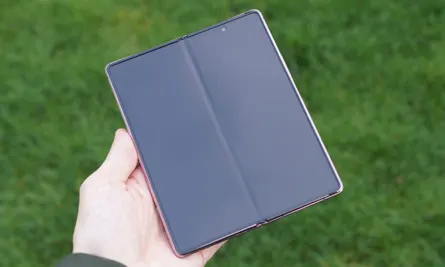Dynamic Island - Doing It Better
- Bailey Tuddenham

- Apr 4, 2023
- 5 min read

“It's very easy to be different, but very difficult to be better.”
- Jony Ive
'Innovation' is an interesting word. According to the Oxford Dictionary, the definition of 'innovation' is "the introduction of new things, ideas or ways of doing something."
Now, different people and companies definitely perceive this in different ways. Some companies rush to be the first to produce something, and they think that that is innovation; being the first to do something. However, I believe that, for Apple, innovation is about being the best and doing things better. It's not necessarily about being the first person to bring out a particular product or feature, but about spending more time and development to make that product or feature perfect. To me, that's much better innovation.
For example, in 2019, Samsung released the first commercially available, foldable, touch screen mobile phone. Now, I'm not going to say that this wasn't innovative, because it definitely was. But, there's a reason why Apple hasn't followed suit yet; there are way too many issues with the technology as it stands. After just days of use, a bulge and crease forms where the touch screen is folded, and dust and debris forms under the hinge. Another major issue is that the screen on the most popular model, the Z Flip, is only designed to be opened and closed 100,000 times. This may seem a lot, but the average person logs onto their phone 150 times a day; this would mean the screen on the Z flip wouldn't even last 2 years. Now, can you imagine Apple releasing a phone that has a crease down the centre of the screen, or dirt that builds up under one of its main components? The chances are, Apple will release a foldable phone in the future. But, just because they weren't the first to do it, it doesn't mean it won't be innovative. Apple won't release a foldable phone until they can do it better; without creasing screens and other imperfections. That's what will make it innovative. It's a lot easier to be the first to do something than it is to perfect that thing.
In 2017, Apple released the iPhone X; one of the first full-screen, bezel-less smartphones. The camera and Face ID components were housed within a 'notch' at the top of the screen. The notch wasn't a hugely popular feature by customers, however I quite liked it. Information, such as wifi signal and the time, were displayed at the top of the screen in the little sections either side of the notch, which I thought was a good use of software to compliment the hardware.

Other companies then began to create similar devices, but with the front camera placed within and surrounded by the touch screen. This got rid of the need of a notch, which as mentioned, wasn't hugely popular amongst the public. However, this looked even worse. Who wants a random black dot shoved in the middle of their screen?! It's also important to note that Apple has a lot more than just a single camera on the front of their smartphone, unlike other mobile phone brands. Due to the technology deigned for Face ID, Apple has a much more sophisticated set of components that need to be housed somewhere. The other brands were going in the right direction, and the idea of having the camera within the screen was definitely innovative, but the execution was atrocious. Cue Apple.
In September, Apple released their latest iPhones; the iPhone 14, iPhone 14 Plus, iPhone 14 Pro and iPhone 14 Pro Max. Whilst the 14 and 14 Plus models still featured the notch, the Pro models had a new design. The camera and Face ID components were redesigned to be within the touch screen, like the other smartphones mentioned previously. However, Apple came up with a brand new idea that made this work well. It's called "Dynamic Island".
Through a really clever use of software, Apple has created a feature within the iPhone software that makes use of the area surrounding the camera, hiding the hardware of the front-facing lens. The dynamic island is a feature that is integrated across the whole IOS software, seamlessly showing you what you need, when you need it. For example, it shows information on the music you're listening to, directions to a location you're navigating to, or controls for a phone call. Its size and shape automatically adapts to what it's being used for, and it can be expanded to interact with more features. The dynamic island is always there, and always showing exactly what you need.

It's an extremely clever use of software engineering and design to not only hide the front camera on the phone, but also to create an amazing new feature that is genuinely useful on a day-to-day basis. I, personally, interact with the dynamic island all of the time, especially whilst listening to music. I think one of the main benefits of it is that you can do things such as change songs without leaving the app that you're on. For example, if I'm playing music in the background and browsing my emails, the dynamic island will display my music information, allowing me to navigate between songs and interact with playback controls, all without leaving the Mail app.

Dynamic Island is also a great example that innovation within technology doesn't have to be physical or hardware related. Clever use of software has enabled a physical, hardware feature to be improved and innovated.
Overall, I think Dynamic Island is a really clever use of software to address an issue faced by technology companies and customers. It addresses the public's feedback regarding the notch on previous iPhone models, and addresses the awful attempts to integrate the camera into the screen from other companies. It is a true piece of innovation and a prime example of doing something better.
Rating
Software Design - 9 / 10
This use of software design is fantastic. By creating an innovative, software based feature, Apple has been able to completely redevelop the hardware of their device. This is something that is very unique to Apple; being the only technology brand that creates software specifically for their hardware and hardware specifically for their software. This is what allows them to make these sorts of groundbreaking features that will, undoubtably, change the industry.
Usability - 10 / 10
Dynamic Island is always there when you need it, and out of the way when you don't. You don't need to think about it; it just works. When you're listening to music, it will display your music info. When you're navigating to a destination, it'll give you updates on directions. It knows what you need, when you need it. And, when you do want to interact with it, its as simple as tapping it to open the expanded features; all of which are familiar.
Fun Factor - 8 / 10
Dynamic Island isn't just a clever feature; it can be fun too! It can pop up with things such sports scores, keeping you up to date on your favourite team! Even just interacting with the Dynamic Island is a fun thing to do; the way that its designed to 'pop' when you expand it is a fun feature that Apple has considered.
Innovation - 10 / 10
This will undoubtably encourage other brands to work with Google to develop similar android software for their devices. The use of software is extremely innovative and has allowed hardware innovation, too. Not only does it hide the hardware in a much better way than competitors, its a great feature that is extremely useful for all sorts of functions.
Aesthetic - 9 / 10
Although it is still an 'obstruction' to the screen, Apple has made it usable. It's not just a black dot that gets in the way of everything you do. It's a usable piece of software that looks great, and has an aesthetic that adapts to what you're doing and what apps you're using. Apple has done an amazing job to make a set of components embedded within a screen look good.
TOTAL - 9.2 / 10





















